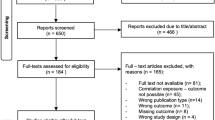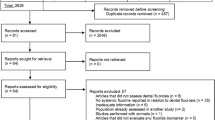Abstract
It is controversial that high-fluoride and high-iodine combined exposure affects the prevalence of dental fluorosis and goiter. The aim of this study was to explore the potential association between high-fluoride and high-iodine combined exposure with dental fluorosis and goiter. We retrieved relevant articles from PubMed, Cochrane Library, China National Knowledge Infrastructure, Wanfang Database and China Science and Technology Journal Database (VIP). The query format was 1 # “Fluorosis” OR “Fluoride,” 2 # “Iodine” OR “Iodide,” and 3 # 1 AND 2. A total of 20 papers were included in this study after independent review by two investigators. Our analysis showed that high-fluoride and high-iodine biphasic exposure was significantly associated with the prevalence of goiter (OR = 4.69, 95% CI 2.82–7.80, P < 0.001). The prevalence of dental fluorosis was also significantly raised (OR = 11.71, 95% CI 7.57–18.14, P < 0.001). Sensitivity analysis suggested that combined statistics of multiple studies were reliable. For goiter, subgroup analysis revealed study province, sample size and published year as sources of heterogeneity (P < 0.001). For dental fluorosis, only sample size was the impact factor of heterogeneity. As well, funnel plot, Begg’s test and Egger’s test suggested there was no publication bias (P > 0.05). Overall, our study demonstrates that high-fluoride and high-iodine combined exposure is a risk factor for occurrence of dental fluorosis and goiter. The chronic of high-fluoride and high-iodine combined exposure is a significant higher risk of disease than normal.






Similar content being viewed by others
References
Allingstrup, M., Wetterslev, J., Ravn, F. B., Møller, A. M., & Afshari, A. (2016). Antithrombin III for critically ill patients: A systematic review with meta-analysis and trial sequential analysis. Intensive Care Medicine, 42(4), 505. https://doi.org/10.1007/s00134-016-4225-7
Alobaidi, R., Morgan, C., Basu, R. K., Stenson, E., Featherstone, R., Majumdar, S. R., & Bagshaw, S. M. (2018). Association between fluid balance and outcomes in critically Ill children: A systematic review and meta-analysis. JAMA Pediatrics, 172(3), 257–268. https://doi.org/10.1001/jamapediatrics.2017.4540
Ba, Y., Ren, L., Yin, G., Cheng, X., Yu, B., Li, S., Ji, X., Zhang, L., & Cui, L. (2009). Effect of different fluoride and iodine concentration in drinking water on children’s dental fluorosis and thyroid function. Chinese Journal Public Health, 25(8), 942–943.
Ba, Y., Zhu, J., Yang, Y., Yu, B., Huang, H., Wang, G., Ren, L., Cheng, X., Cui, L., & Zhang, Y. (2010). Serum calciotropic hormone levels, and dental fluorisis in children exposed to different concentrations of fluoride and iodine in drinking water. Chinese Medical Journal, 123(6), 675–679.
Cao, Q., Yang, L., Ren, W., Song, Y., Huang, S., Wang, Y., & Wang, Z. (2021). Spatial distribution of harmful trace elements in Chinese coalfields: An application of WebGIS technology. The Science of the Total Environment, 755(Pt 1), 142527. https://doi.org/10.1016/j.scitotenv.2020.142527
Chen, D. (2014). The effect of fluoride on iodine excess goiter and indicators of oxidative stress. Harbin Medical University.
Demelash, H., Beyene, A., Abebe, Z., & Melese, A. (2019). Fluoride concentration in ground water and prevalence of dental fluorosis in Ethiopian Rift Valley: Systematic review and meta-analysis. BMC Public Health, 19(1), 1298. https://doi.org/10.1186/s12889-019-7646-8
Duan, D., Ding, N., & Gang, G. (2003). Prevalence of dental fluorosis and goiter among primary school students after drinking high fluoride and iodine water in Shanghe County. Preventive Medicine Tribune, 9(1), 28–29.
Farebrother, J., Zimmermann, M. B., & Andersson, M. (2019). Excess iodine intake: Sources, assessment, and effects on thyroid function. Annals of the New York Academy of Sciences, 1446(1), 44–65. https://doi.org/10.1111/nyas.14041
Fu, Y., Lee, C., & Chi, C. (2018). Association of psoriasis with inflammatory bowel disease: A systematic review and meta-analysis. JAMA Dermatology, 154(12), 1417–1423. https://doi.org/10.1001/jamadermatol.2018.3631
Hong, F., Cao, Y., & Liu, H. (1997). Investigation on the distribution of high fluoride and high iodine water and its hazards in Binzhou area. Preventive Medicine Tribune, 3(4), 341–342.
Hong, F., Cao, Y., Yang, D., & Wang, H. (2001a). A study of fluorine effects on children’s intelligence development under different environments. Chinese Primary Health Care, 15(3), 56–57.
Hong, F., Wang, H., Yang, D., & Zhang, Z. (2001b). The study of children’s intelligence and metabolism levels of iodine and fluoride. Chinese Journal of Control of Endemic Diseases, 16(1), 12–14.
Hong, F., Yang, D., Xu, X., & Ming, H. (2001c). The prevalence of endemic goiter and endemic dental fluorine due to the water that contains high iodine and fluoride. Occupation and Health, 17(12), 89–90.
Hou, G., Chen, G., Sun, N., Zhang, L., Liu, Y., Yuan, C., Yang, J., Zheng, H., & Hao, Z. (2016). Effect of high fluoride and iodine in drinking water on serum immune substance level of children aged 8–10. Contemporary Medicine, 22(30), 3–4.
Jha, S. K., Singh, R. K., Damodaran, T., Mishra, V. K., Sharma, D. K., & Rai, D. (2013). Fluoride in groundwater: Toxicological exposure and remedies. Journal of Toxicology and Environmental Health Part b, Critical Reviews, 16(1), 52–66.
Li, L., Wu, J., Lu, J., Min, X., Xu, J., & Yang, L. (2018). Distribution, pollution, bioaccumulation, and ecological risks of trace elements in soils of the northeastern Qinghai-Tibet Plateau. Ecotoxicology and Environmental Safety, 166, 345–353. https://doi.org/10.1016/j.ecoenv.2018.09.110
Li, X. (2008). Epidemiological study on synergistic hazards of water-borne high iodine and fluorine. Harbin Medical University.
Liu, Y., Chen, G., Hou, G., Yu, B., Zheng, H., & Hao, Z. (2013). Study on the influence of high iodine and high fluoride in drinking water on goiter and dental fluorosis in children aged 8–10. Contemporary Medicine, 19(1), 1–3.
Liu, J., Liu, L., Jia, Q., Zhang, X., Jin, X., & Shen, H. (2019). Effects of excessive iodine intake on blood glucose, blood pressure, and blood lipids in adults. Biological Trace Element Research, 192(2), 136–144. https://doi.org/10.1007/s12011-019-01668-9
Liu, S., Chen, W., & Chi, C. (2020). Association between medication use and bullous pemphigoid: A systematic review and meta-analysis. JAMA Dermatology, 156(8), 891–900. https://doi.org/10.1001/jamadermatol.2020.1587
Naseer, B., Tan, S. S. G., Ramli, S. S., & Ang, E. (2017). Protected mealtimes for adults with cancer in a hematology-oncology setting: An evidence-based implementation project. JBI Database of Systematic Reviews and Implementation Reports, 15(4), 1209–1219. https://doi.org/10.11124/JBISRIR-2016-003038
Qu, T., Mou, Y., Wang, Y., Zheng, J., Dai, J., He, Z., & Gu, S. (2021). The effect of high fluoride exposure on the level of children’s intelligence: A meta-analysis. Modern Preventive Medicine, 48(3), 438–442.
Tadesse, A. W., Gereslassie, T., Xu, Q., Tang, X., & Wang, J. (2018). Concentrations, distribution, sources and ecological risk assessment of trace elements in soils from Wuhan, Central China. International Journal of Environmental Research and Public Health, 15(12), E2873. https://doi.org/10.3390/ijerph15122873
Tian, Y., Li, J., & Liu, J. (2016). The influence of thyroid function of 8–10 years old children by chronic exposure of high iodine combine high fluoride. Chinese Journal of Control of Endemic Diseases, 31(6), 660–661.
Velasco, I., Bath, S. C., & Rayman, M. P. (2018). Iodine as essential nutrient during the first 1000 days of life. Nutrients, 10(3), E290. https://doi.org/10.3390/nu10030290
Vidranski, V., Radman, A., Kajić, K., & Bronić, A. (2020). Knowledge and awareness of iodine intake—Survey among Croatian women of reproductive age. Biochemia Medica, 30(1), 010705. https://doi.org/10.11613/BM.2020.010705
Wan, S., Jin, B., Ren, B., Qu, M., Wu, H., Liu, L., Boah, M., & Shen, H. (2020). The relationship between high iodine consumption and levels of autoimmune thyroiditis-related biomarkers in a Chinese population: A meta-analysis. Biological Trace Element Research, 196(2), 410–418. https://doi.org/10.1007/s12011-019-01951-9
Wang, X., Wang, L., Hu, P., Guo, X., & Luo, X. (2001). Effects of high iodine and high fluorine on children’s intelligence and thyroid function. Chinese Journal Endemiology, 20(4), 288–290.
Wang, R. (2012). Joint Effects of Excessive Fluoride and iodine in Drinking Water on Children’s Thyroid and Intelligence Development. Tianjin Medical University.
Wei, W., Pang, S., & Sun, D. (2019). The pathogenesis of endemic fluorosis: Research progress in the last 5 years. Journal of Cellular and Molecular Medicine, 23(4), 2333–2342. https://doi.org/10.1111/jcmm.14185
Wu, Y., Sun, J., Wang, M., Yu, G., Yu, L., & Wang, C. (2018). The relationship of children’s intelligence quotient and blood lead and zinc levels: A Meta-analysis and system review. Biological Trace Element Research, 182(2), 185–195. https://doi.org/10.1007/s12011-017-1093-0
Yan, R., Xu, R., Zhou, Y., Li, Y., Pang, Y., Liu, J., Hu, X., Yang, F., Wen, S., Zhang, L., Ren, J., & Liu, M. (2019a). Effects of iodine and fluoride content in drinking water on prevalence of adults thyroid nodules in Cangzhou Hebei. Chinese Journal of Endemiology, 38(6), 472–475.
Yan, R., Zhou, Y., Li, Y., Xu, R., Li, S., Wen, S., Li, X., Zhang, L., Meng, Y., Ren, J., & Liu, M. (2019b). Detection of thyroid nodules in children from areas with different drinking water iodine and fluoride contents in Cangzhou, Hebei Province. Journal of Environmental and Occupational Medicine, 36(5), 470–478.
Yang, K., Wang, X., & Guo, X. (1994). Effects of high iodine and high fluorine on children’s intelligence and the metabolism of iodine and fluorine. Chinese Journal of Epidemiology, 15(5), 296–298.
Yang, H., Liu, J., & Zhang, Z. (2002). Study on the elimination of biphasic harm of high iodine and high fluoride water source to human health in Binzhou area. Chinese Journal of Control of Endemic Diseases, 17(2), 98–100.
Yu, X. (2018). Effect of high fluoride and high iodine drinking water on the prevalence of dental fluorosis among school aged children in rural areas of Shenyang City. Chinese Journal of Public Health Engineering, 17(5), 696–697.
Zhao, L., Shi, X., & Wei, L. (2016). Effect of high fluoride and high iodine drinking water on rural school-age children’s dental fluorosis prevalence of Weifang area. Chinese Journal of Control of Endemic Diseases, 31(2), 156–158.
Zhao, H., Li, H., & Huang, T. (2019). High iodine intake and central lymph node metastasis risk of papillary thyroid cancer. Journal of Trace Elements in Medicine and Biology: Organ of the Society for Minerals and Trace Elements (GMS), 53, 16–21. https://doi.org/10.1016/j.jtemb.2019.01.015
Funding
This research was supported by grants from the National Natural Science Foundation of China (no. 82060585) and Yunnan Provincial Education Department Scientific Research Fund (no. 2021Y423).
Author information
Authors and Affiliations
Contributions
YM contributed to the study idea, methodological evaluation and manuscript drafting. TQ made a major contribution to data collection, data analysis and manuscript drafting. RW performed part of the data analysis and drafted the search strategy and inclusion criteria for the study. YZ did other part of the data analysis and explanation, as well as the manuscript revision. ZH and SG designed and edited the manuscript.
Corresponding author
Ethics declarations
Data availability
Our data came from the databases, including PubMed, Cochrane Library, China National Knowledge Infrastructure (CNKI), Wanfang Database and China Science and Technology Journal Database (VIP). So, we used the collected data for the research in this study.
Ethics approval and consent to participate
This article did not contain any studies performed by the authors on human or animal subjects. All participants provided informed consent before joining in the study.
Conflict of interest
All authors declare that they have no competing interests.
Additional information
Publisher's Note
Springer Nature remains neutral with regard to jurisdictional claims in published maps and institutional affiliations.
Rights and permissions
Springer Nature or its licensor holds exclusive rights to this article under a publishing agreement with the author(s) or other rightsholder(s); author self-archiving of the accepted manuscript version of this article is solely governed by the terms of such publishing agreement and applicable law.
About this article
Cite this article
Mou, Y., Qu, T., Wang, R. et al. The association of high-fluoride and high-iodine combined exposure with dental fluorosis and goiter: a meta-analysis. Environ Geochem Health 45, 3143–3153 (2023). https://doi.org/10.1007/s10653-022-01396-5
Received:
Accepted:
Published:
Issue Date:
DOI: https://doi.org/10.1007/s10653-022-01396-5




